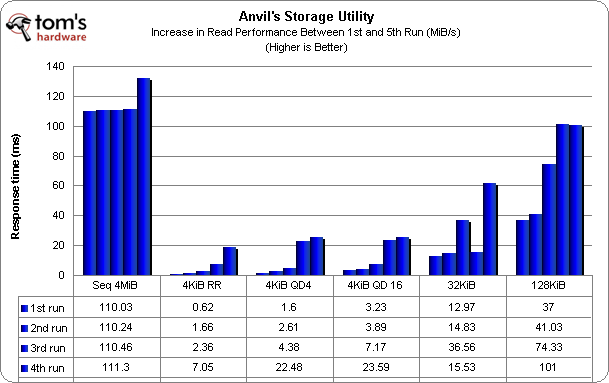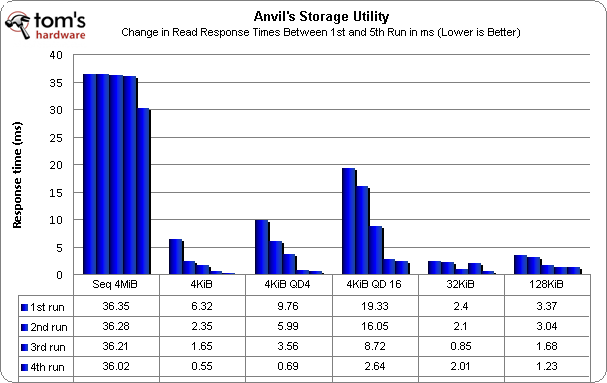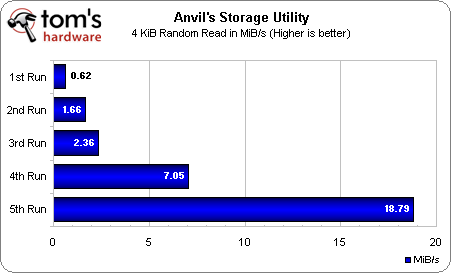In The Lab With Seagate's Momentus XT 750 GB Hybrid HDD
More than two years after reviewing Seagate's first-generation Momentus XT, we're back in the lab with a 750 GB model armed with 8 GB of SLC NAND and a SATA 6Gb/s interface. How does it compare to pure solid-state and hard drive technologies? We dig deep.
Benchmark Results: Anvil's Storage Utility
So, we know that, in order to explore the benefits of the Momentus XT, we need a metric able to get information from the drive's spinning media to its NAND flash. We're going to achieve this using Anvil’s Storage Utility (ASU).
ASU is flexible, so we can configure its benchmark parameters. In this test, specifically, we're creating a test file size of 1 GiB, which can subsequently be re-read multiple times. ASU bypasses the file system cache within the operating system. As a consequence, variation in speed can be directly attributable to the NAND cache. For our purposes, we’re using a freshly-formatted Momentus XT connected to a secondary SATA 6Gb/s port.
After each successive run, small block transfers become significantly faster. Peak performance is achieved after five runs. Four-megabyte block transfers are, conversely, more or less unaffected after each run. Clearly, the Momentus XT is designed to accelerate the small blocks that take a long time to access from the hard disk platter. Placing those blocks in on-board flash allows them to be read much faster, leaving the hard drive to address read and write requests it can more efficiently serve from physical media.
Four-kilobyte random read performance increases exponentially after each run, starting off at 0.62 MiB/s on the first run and ramping up to 18.79 MiB/s by the fifth. That’s comparable to the performance of an SSD.
Thirty-two-kilobyte and 128 KiB block transfer speeds also improve significantly, though not by the same impressive margin as 4 KiB transfers (which increase by nearly 3000%).
Get Tom's Hardware's best news and in-depth reviews, straight to your inbox.
Current page: Benchmark Results: Anvil's Storage Utility
Prev Page Benchmark Results: AS SSD Next Page Benchmark Results: Boot-Up In hIOmon-
sunsmasher So it sounds like the hot setup is SSD for OS/Apps, and HHDD for storage of frequently used media, with a 2TB+ hard drive for storage/archiving of other media.Reply -
americanbrian I don't like your spider graph for reliability.... Does the Hybrid Drive still "work" when either the flash or spinning discs fail?Reply
If not (which it is easy to argue it would at least not be working properly if at all). Then you must say it has twice the chance at failure. This is because if there is a 1:1000 chance of the HD part failing, and a 1:1000 cahnce of the flash failing (your spider shows them to be roughly equal) then there is a 2:1000 chance of "drive" failure in total (or 1:500).
That is called "probability" it is funny like that. Think of it like a weird RAID 0 array. -
hunshiki The idea is great in my opinion, but they could include a 16gb SSD inside the drive. Or 32.Reply -
akamrcrack Would have been nice to see you include SSD caching drives like the Crucial Adrenaline in this study.Reply
My Adrenaline + Samsung Spinpoint F3 1TB 7200rpm HDD say they are the better buys :)
Installed my OS onto my HDD (was originally on a Crucial M4 64GB) then installed the Caching software from Dataplex and watched the sparks fly!
Now my Spinpoint runs as fast as my Intel 320 series 120GB SSD in CrystalDiskMark :)
Plus I can always upgrade to a 2TB HDD meaning I can have 2TB of space running at SSD speeds all day :)
When you are a srs gamer like me and you have hundreds of games to store and no SSD capable of holding them, you begin to want to find solutions to solve that. Well ever since I installed the caching drive + software (very simple) everything about my HDD is fast!
Momentus is old and tried. The only thing I know of that can match the performance of my HDD+SSD cache is a new gen velociraptor 1TB HDD that costs around $320. Which could get me 2TB of storage and the SSD cache and still have money left over lol so neither new gen raptors or momentus are worth the cost unless you are limited to 1x 3.5" bay in your computer.. Even then a 2.5" SSD is very easy to hide in a case..
I've seen the argument "why not just get a regular SSD instead of the Adrenaline, won't they do the same thing?"
My response to that is, for the average user that wants simplicity getting a SSD premade for caching that comes with quality software is the way to go. The Dataplex software is very very light and as simple as install then forget it existed. -
A comparison with Intel's SRT technology (combines up to 64GB SSD with a traditional HD) would have been interesting. I wonder what evidence made Intel choose 64GB and Seagate choose 8GB? What is the optimal amount of SSD to pair with an HD generally speaking?Reply
-
mariusmotea To test a Hybrid drive you need to use it several hours. of course that benchmarks files has been cached into the SSD. Let's see the startul speed after i browse the internet for few hours and play a game for 30 minutes. I don't belive that the statup files will be in ssd anymore.Reply -
dthx Of course a SSD + big 3.5 drive is always a better solution but... impossible to achieve in most portable PC's. This is where the hybrid shines: you don't have to choose between decent performances and sufficient and affordable capacity. I've put such a drive (and Win7 instead of Vista) in a 4 year old XPS-1330 and after a few reboots it has become an extremely capable machine (faster than any brand new laptop with a conventional HDD).Reply -
cscott_it I recall another site (maybe Anandtech?) putting a couple of these in a RAID 0 configuration and the performance scaled rather nicely. Any chance you guys are thinking about doing something like that?Reply



